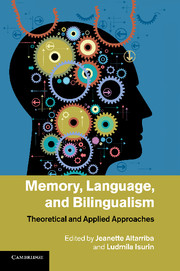Book contents
- Memory, Language, and Bilingualism
- Memory, Language, and Bilingualism
- Copyright page
- Contents
- Figures
- Tables
- Contributors
- Introduction
- 1 Bilingual memory:
- 2 Lexical competition in localist and distributed connectionist models of L2 acquisition
- 3 Working memory and (second) language processing
- 4 Working memory in simultaneous interpreters
- 5 Using electrophysiological measures to track the mapping of words to concepts in the bilingual brain:
- 6 Age effects in L2 learning:
- 7 Bilingualism, language, and aging
- 8 Crossovers and codeswitching in the investigation of immigrant autobiographical memory
- 9 Linguistic relativity and bilingualism
- 10 Testing effects for novel word learning in Chinese–English bilinguals
- 11 The lexicon in second language attrition:
- 12 Memory and first language forgetting
- 13 Future research directions:
- Index
1 - Bilingual memory:
Structure, access, and processing
Published online by Cambridge University Press: 05 November 2012
- Memory, Language, and Bilingualism
- Memory, Language, and Bilingualism
- Copyright page
- Contents
- Figures
- Tables
- Contributors
- Introduction
- 1 Bilingual memory:
- 2 Lexical competition in localist and distributed connectionist models of L2 acquisition
- 3 Working memory and (second) language processing
- 4 Working memory in simultaneous interpreters
- 5 Using electrophysiological measures to track the mapping of words to concepts in the bilingual brain:
- 6 Age effects in L2 learning:
- 7 Bilingualism, language, and aging
- 8 Crossovers and codeswitching in the investigation of immigrant autobiographical memory
- 9 Linguistic relativity and bilingualism
- 10 Testing effects for novel word learning in Chinese–English bilinguals
- 11 The lexicon in second language attrition:
- 12 Memory and first language forgetting
- 13 Future research directions:
- Index
Summary
Language and memory are closely intertwined in the human cognitive architecture. Language acquisition depends on successful memory encoding and retrieval; at the same time, language itself is instrumental for encoding and storing knowledge. For bilinguals, the need to keep their two languages functionally distinct influences memory. In this chapter, we review the structure of bilingual memory, including long-term, short-term, and phonological working memory and how they are influenced by knowledge of multiple languages. We also investigate memory access and review research on episodic memory access in bilinguals and on semantic memory access during bilingual language comprehension and production. We then examine processing in the context of existing models of bilingual language and memory. Finally, we consider how the prism of novel language learning can provide insight into the interaction between memory and language. We conclude that bilingualism changes the human cognitive architecture and affects the structure, access, and processing of language and memory.
- Type
- Chapter
- Information
- Memory, Language, and BilingualismTheoretical and Applied Approaches, pp. 7 - 47Publisher: Cambridge University PressPrint publication year: 2012
- 7
- Cited by



